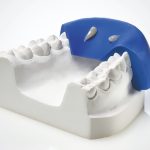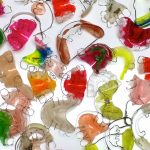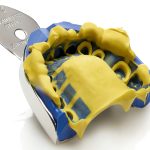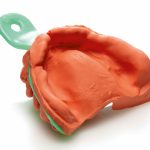
When taking an impression of implants, it is essential to reproduce their position with the utmost precision in all three dimensions. Whenever an implant has an ankylotic connection to the bone, it is extremely important for the prosthesis to connect to it passively in order to avoid creating stresses on the biological tissues and prosthetic components [1].
Many different factors impact accuracy and precision when taking impressions of implants [2]: impression materials for a start, but even more so the technique adopted [3]. As far as materials are concerned, elastomers are the most commonly used, as they deliver excellent results in terms of accuracy, precision and dimensional stability [4]. In all prosthetic rehabilitation procedures, of course, you need to assess the differences between impression materials in relation to the specific clinical case and the chosen impression taking technique [1].
The choice of impression taking technique, on the other hand, is a different matter. In the production of implant prosthetics, there are two main impression taking techniques: “pick-up” and “closed tray”.
“Pick-up” and “closed tray” impressions
The “pick-up” technique is also referred to as the “open tray” technique. In this technique, the transfers remain encased in the impression material after the impression has been removed from the patient’s mouth.
In “closed tray” impressions, on the other hand, the transfers remain attached to the implants after the impression material has been cured. The transfers then have to be removed from the patient’s mouth and repositioned in the impression.
Each of these techniques has its advantages and disadvantages and choice depends partly on the preferences of the dentist and dental technician, though it is also influenced by the chemical and physical properties of the chosen impression material.
Advantages and disadvantages of the “pick up” and “closed tray” impressions
Of the two techniques, the “pick-up” technique is the more accurate and precise as the transfers remain stably encased in the impression material and the position of the implant is therefore accurately reproduced in the model [2].
With “closed tray” impressions, on the other hand, the transfers are held less securely by the impression material, and their positions can vary more easily when the stone model is cast as a result of expansion during the hardening process [5,6].
Another factor that negatively impacts the accuracy of “closed tray” impressions is the force generated around the transfers when the impression is removed from the oral cavity. The stress induced in the impression material in order to overcome the resistance of the transfers can cause deformation in the material, or even an actual tear, making it difficult to reposition the transfer and leading to a distorted reproduction of the true position of the implant.
With “closed tray” impressions, however, you avoid the delicate phase of connecting the transfer to the analogue in the laboratory, a step that is of fundamental importance in the “pick-up” technique and has to be performed while the transfer is still encased in the impression material. During this step (which is only needed in the “pick-up” technique), if the transfer moves or rotates in the impression material, the position of the implant in the model will certainly be altered, along with the passive fit of the subsequent prosthesis [7,8]. For clinical reasons, in all “pick-up” procedures it is therefore essential to take the greatest care to ensure good adhesion between the transfer and the impression material, either by thoroughly drying the transfer or by applying adhesive to the impression material [2].
Such care is not necessary with “closed tray” impressions, which are therefore quicker to take, do not require custom or open (modified) trays, and are therefore less costly to produce. In addition, the transfers used in the “closed tray” technique are not so long as those needed for the “pick-up” technique. This is another advantage for both patient and dentist, especially in treatments involving the distal regions of the oral cavity, where there is less space between the arches and it can prove difficult to screw long transfers in and out. In clinical cases involving patients with reduced oral apertures too, “closed tray” transfers are far easier to use.
The main disadvantage of the “closed tray” impression taking technique is therefore the difficulty encountered in repositioning transfers in the impression material. The dental practice may well not notice inaccurate positioning. Manufacturers of dental products have come up with various solutions to this problem and have modified the shape of their transfers or produced caps in various materials that fit over the transfer and can be removed with the impression to make it easy to reposition the transfers later.
To conclude, “open pick-up” impressions are the most accurate and precise and should be preferred whenever possible. However, if a case presents any clinical peculiarities, the “closed tray” technique offers a valid alternative. The objective of the procedure must not, however, be forgotten: in any rehabilitation involving multiple implants, prostheses must fit passively over their implants and not generate stresses between them.
The Zhermack solution for taking impressions of implants
Hydrorise System is Zhermack’s range of addition silicones for taking impressions of implants and natural abutments, and is specially formulated for practitioners seeking high performance solutions.
Hydrorise Implant is scannable and has the ideal rigidity for taking impressions of implants. Hydrorise also boasts excellent detail reproduction and, thanks to high hydrocompatibility, improves precision and accuracy in impressions of natural abutments.
References:
[1] Baldissara P, Koci B, Messias AM, Meneghello R, Ghelli F, Gatto MR, et al. Assessment of impression material accuracy in complete-arch restorations on four implants. J Prosthet Dent 2021. https://doi.org/10.1016/j.prosdent.2020.10.017.
[2] Lops, D., Bruna, E., & Fabianelli, A. (2014). La protesi implantare. Dental Cadmos, 6(82), 386. n.d.
[3] Wee AG. Comparison of impression materials for direct multi-implant impressions. J Prosthet Dent 2000;83:323–31. https://doi.org/10.1016/s0022-3913(00)70136-3.
[4] Assif D, Fenton A, Zarb G, Schmitt A. Comparative accuracy of implant impression procedures. Int J Periodontics Restorative Dent 1992;12:112–21.
[5] Baig MR. Multi-unit implant impression accuracy: A review of the literature. Quintessence Int 2014;45:39–51. https://doi.org/10.3290/j.qi.a30769.
[6] Kim S, Nicholls JI, Han C-H, Lee K-W. Displacement of implant components from impressions to definitive casts. Int J Oral Maxillofac Implants 2006;21:747–55.
[7] Del’Acqua MA, Chávez AM, Compagnoni MA, Molo F de A. Accuracy of impression techniques for an implant-supported prosthesis. Int J Oral Maxillofac Implants 2010;25:715–21.
[8] Moreira AHJ, Rodrigues NF, Pinho ACM, Fonseca JC, Vilaça JL. Accuracy Comparison of Implant Impression Techniques: A Systematic Review: Accuracy of Implant Impression Techniques. Clinical Implant Dentistry and Related Research 2015;17:e751–64. https://doi.org/10.1111/cid.12310.
Do you want more information on Zhermack Dental products and solutions?
Contact Us




 Zhermack SpA has been one of the most important producers and international distributors of alginates, gypsums and silicone compounds for the dental sector for over 40 years. It has also developed solutions for the industrial and wellbeing sectors.
Zhermack SpA - Via Bovazecchino, 100 - 45021 Badia Polesine (RO), Italy.
Zhermack SpA has been one of the most important producers and international distributors of alginates, gypsums and silicone compounds for the dental sector for over 40 years. It has also developed solutions for the industrial and wellbeing sectors.
Zhermack SpA - Via Bovazecchino, 100 - 45021 Badia Polesine (RO), Italy.


